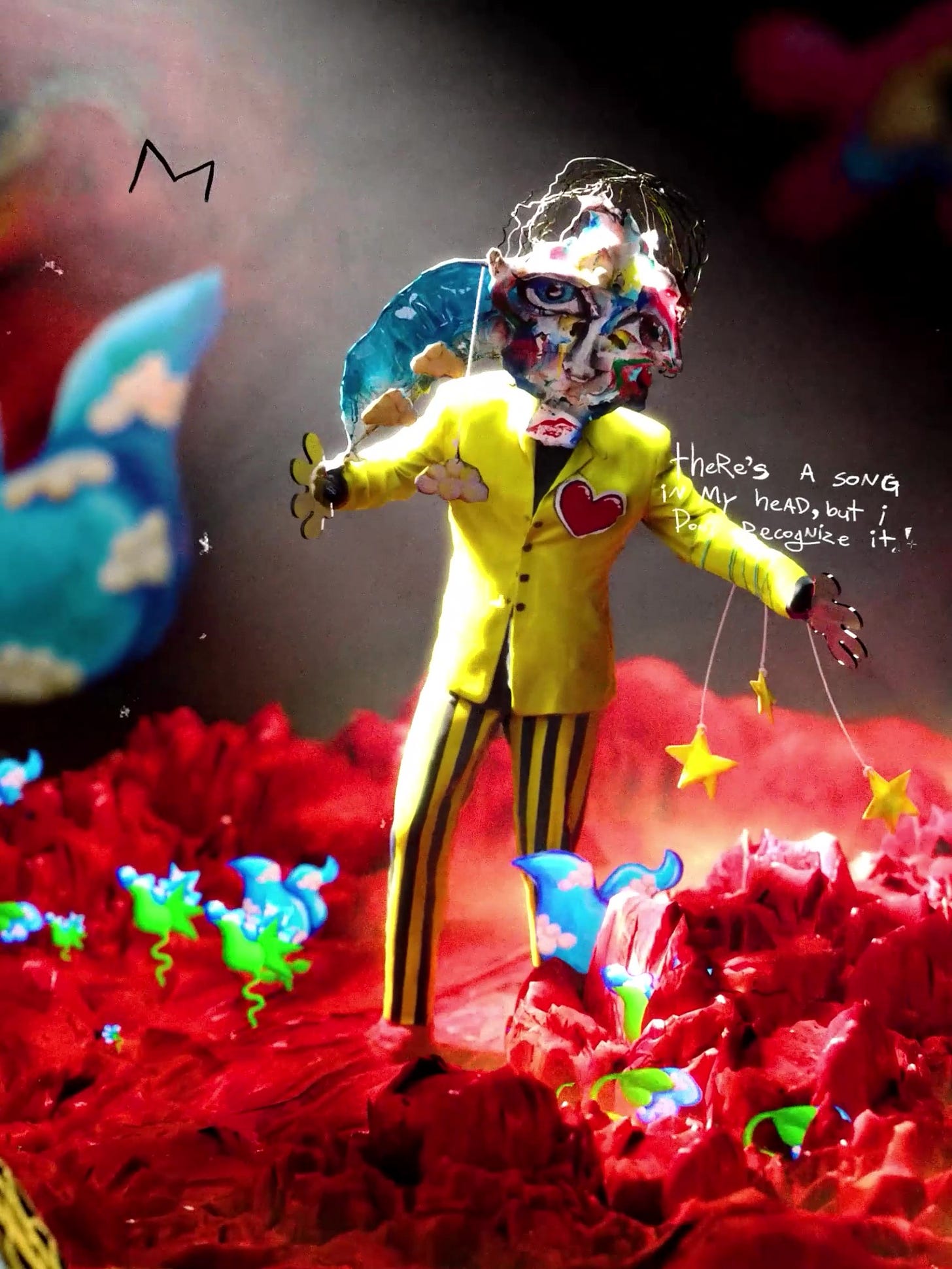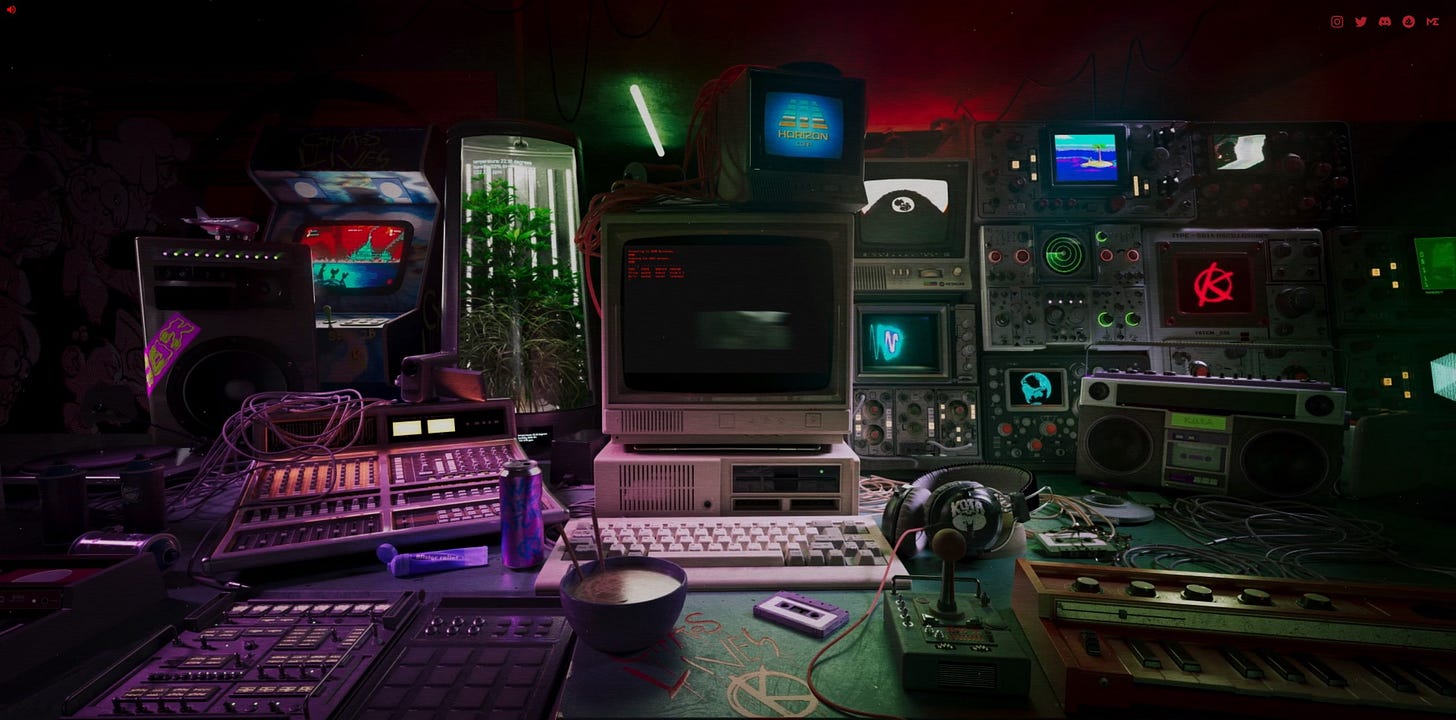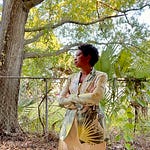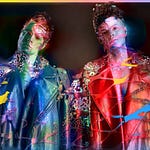Welcome to the FuturePerfect Podcast where we talk with compelling people breaking new ground in art, media, and entertainment. This podcast is produced by FuturePerfect Studio, an extended reality studio creating immersive experiences for global audiences. Visit our website futureperfect.studio for more details.
The text version of this interview has been edited for length and clarity. Find the full audio version above or in your favorite podcast app.
For episode 006, Wayne Ashley interviews Andrew Keller, founder of We Few Group, a post-media company that manages singers and songwriters, and develops brand partnerships and ventures with internationally known visual and musical artists. Making innovative use of blockchain technologies and NFTs, Andrew has been building compelling projects with such noted organizations as the David Bowie Estate and singer-songwriter Stefan Storm.
Early career at Columbia Records
Let me start right off by saying how excited I am to be speaking to someone who’s been part of the music industry for over 20 years. As much as I love music, I’ve had very little access to the inside workings of the business. You’ve had these long relationships with labels like Columbia and Capitol Records. What are some of the most important insights you’ve gained over the last two decades?
Andrew Keller: One of the biggest insights I’ve gained is that change is necessary and hard. When you’re dealing with global major labels it’s really hard to make noticeable changes. There’s a lot of people working at major labels who are innovative and want to do good. It’s just really hard to turn a gigantic ship around. You’re dealing with all sorts of policies and god knows how many different types of contracts that were written over the years.
How did you get started at Columbia Records and what were your major focuses were when you were there?
AK: I started at Columbia as a 17 year old and was a total music-head. I grew up in New York City so I had access to absolutely everything, and thankfully, I had parents who were simultaneously really supportive and also slightly oblivious. From the time I was 13 or 14 I was going out to places I probably shouldn’t have been and exploring all sorts of different scenes from nightclubs to hardcore and punk shows to mainstream pop shows. I was really giving myself a crazy education in different subcultures and figuring out little scenes and pockets that had their own worlds, archetypes, and systems in place. And they’re probably all relatively similar, it’s just people wearing different clothes and different hair. But the whole concept of having these scenes and worlds always excited me. It kind of all played into ideas of identity—sonic identity and visual identity.
I was going to lots of shows around 2002 when there was this giant emergence of bands in the tri-state area who were coming out of the punk scene. And it became kind of this pop-punk, emo, screamo post-hardcore thing. I refer to it lovingly as the Warped Tour-scene, which was this festival that traveled around the US for years. There was a ton of attention on bands that I was friends with and bands that I had built relationships with as a fan.
One thing kind of led to another and I ended up getting hired as a junior A&R scout / assistant at Columbia and got to work for some amazing people. One of whom is kind of this incredibly legendary small bald man named Matt Pinfield, who was a DJ and then VJ on MTV. A lot of the time we kind of ended up having a deal where he would get booked to DJ and then I would basically cover his set and he’d split the money with me if he had to leave.
So I started DJing and it was just this awesome moment in time where I was really young and exposed to so many people. It became clear to me at that point that I just loved being around creative people. I was never in a band. I don’t sing. I don’t consider myself an artist in any way, shape or form. I do consider myself a creative person and a professional fan. I realized early on that for me it was gonna be about being the conduit and the kind of middle man between the artist and the rest of the world.
That period of time was really incredible. I got to work on MGMT’s first two albums as a coordinator then started to sign bands on my own like Cults and St. Lucia and doing stuff in the dance space with Krewella and Dillon Francis. And then one of the last things I got to do at Columbia was Bring Me the Horizon, which as a metal kid was unreal. And that was all under a guy named Ashley Newton, who is still one of my closest friends and mentors. He was responsible for signing Spice Girls, Massive Attack, Daft Punk, and Pharrell. Ultimately I went with him and Steve Barnett, who had been the chairman of Columbia, over to Capitol Records when Steve was relaunching Capitol.
Streaming music, shifts in the industry, and joining Capitol Records
I’m very interested in the sort of crises that upend one’s assumptions about the world and motivate people to do something radically different than what they’ve been doing. You mentioned inertia in the music industry when we talked earlier. What happened that caused you to leave Columbia, join Capitol and eventually start your own company?
AK: There were a few things. I was 30 and had started at Columbia when I was 17 and I really wanted a change. I loved my artists and everyone I worked with. It really was a family, but I was too comfortable. If you do A&R at a label your real challenge at the end of the day is to sell records. Your goal is to find artists, help them make the best record possible and have as much success as you can. There’s a million ways to do it, and I’m not even saying I was great at it, but it’s a very linear goal. You go from point A to point B, and that’s fine, but it had just done so much and I needed a change.
So Steve Barnett called me and said what would you want to do if you were going to stay at a label? And my answer was that streaming was starting to become really dominant. And the thing that streaming changed was access to global music. Before streaming if you were a British band you would sign to a label in the UK for the world. But unless something really took off, you might not even get a US release. When Spotify started putting out music, for the most part, nothing was geo-locked. Everything was coming out day and date, but labels were still working territorially.
So I said to Steve, I think there’s gonna be a really big shift in the way music is consumed from an international standpoint and I wanted to create “international A&R 2.0” for streaming. So off I went to Capitol Records where I started figuring out this whole system. And also taking systems that were already in place and trying to break them because there were things that didn’t make sense to me and that I thought needed to be changed. Part of that was really just being the ambassador and being the person who could go and have some difficult conversations. But also go and represent Capitol around the world. It was a lot of time on airplanes.
I had a ton of fun at Capitol. I got to partner with Lewis Capaldi who is on his arena tour right now and is a fantastic artist. I introduced Capitol to SM Entertainment, one of the biggest K-pop labels in the world, and they have an amazing and fruitful partnership. When I reached the end of my deal at Capitol I was in my thirties and my brand had always been owned by a major corporation. There were things I wanted to do that I’d never be able to do in those situations. For example I wouldn’t be able to music supervise a movie, I wouldn’t be able to launch my own projects or do certain things.
An open-ended post-media company
From here you started your own company We Few Group. I like to call it an “open-ended post-media company”. You take on so many roles—an artist manager, a mixing engineer, an NFT project producer, an entertainment strategy consultant, you’re also working closely with visual artists to produce a graphic novel and even knitwear. This kind of post-media practice that you engage in is so exciting to me and it’s exactly what FuturePerfect is doing. How are these different worlds and practices connected for you?
AK: When I went off to start We Few Group everyone was like what is it, what are you going to do? And I just said I’m going to do things that excite me with people I like. And that was it, that’s the entire thing.
For example, you mentioned the knitwear. A couple of years ago, there was a painter that I was obsessed with and I wanted to buy his paintings. I ended up getting on a Zoom call with him for over two hours talking about what he was doing. At the end of the call he asked—if I manage artists could I also manage a painter? He’s in the kind of traditional art world, but makes these 30-second horror films around each of his pieces on TikTok. It’s all kind of neo-gothic stuff.
He has all of these kids as fans, everyone from artists and influencers and just regular teenagers and 20-somethings, the typical TikTok audience. And they all wanted merch. They weren’t necessarily buying fine art, but they wanted merch. And he and I started having conversations about it. He wasn’t really interested in making merch because he is an artist, but he was like, I’ll start a clothing company. Next thing you know, I’m learning about knitwear.
This connects back to your earlier question of why I was leaving. The answer is I wasn’t learning stuff. There was no time in my life at a label that I would ever be learning about making knitwear, or consulting for Arizona Iced Tea and helping them with their entertainment strategy for two years. I now know more about consumer packaged goods and beverage production and can wrapping. Is that the world’s most useful thing to know [laughs]? No but I love learning that kind of stuff and being around it.
Crypto and transforming artistic engagement
This brings me now to your fascination with the crypto space. That’s another expansive world. What about crypto most excites you and your efforts to transform both artistic and business practices? How did you get into it?
AK: I got into crypto early. I’ll preface this with saying it’s not because I bought millions of Bitcoin at $2 and am now sitting here just pounding money. I wish that were the case, but it’s not. I started buying little fragments of Bitcoin in like 2010. Growing up things like business and banking and the stock market were like the devil to me. For better or worse, I kind of vilified it in my mind. But with crypto it felt almost like punk rock banking. I was completely intrigued by it as a kind of rebellion. For years friends heard me talking about crypto, and when the pandemic started and touring was shut down there was suddenly a bull market mentality in the crypto space. And NFTs, which had been around for a few years prior, started to be something that artists, managers and agents were paying attention to. People started calling me saying you probably know about this stuff, right?
I gave pretty much everyone the exact same conversation. I said please don’t do this, it is really early. This is a real world and kind of culture. You do not care about them. They do not really care about you. Your fans do not care. You know, this is bad for everyone. I guess not a lot of people were voicing that at the time. A lot of people were saying we should do this and people made a bunch of money, but I think a lot of them also looked a little dumb. A lot of the projects were pretty empty. Most of them don’t get talked about anymore.
But as this world kept growing I started getting calls again. I realized that I could help be a middle man and tour guide. I could help bring the right people with the right intentions in and help shape what adoption to Web3 looked like and help introduce people to the real crypto-native world and to the people who really care about this. A lot of what I do now with Web3 is try to find interesting projects and people who I think will love and enjoy this space and help them either dip their toe in the water or jump in the right way surrounded by the right people.

Working with the David Bowie Estate
Talk about the David Bowie project, because clearly this is something that you have a lot of passion for, and through it we can better understand what you mean by NFT, crypto space or blockchain.
AK: It was without a doubt, one of the most incredible and surreal things I have and probably will ever get to be a part of. Let’s put it this way, when my son came home from the hospital in his nursery at home over the changing table is a caricature of David Bowie. My dog’s name is Bowie. I’m not a casual Bowie Fan. I revere Daivd Bowie.
I couldn’t write it better. I’m sitting on the computer one night buying something on the NFT marketplace OpenSea with my dog Bowie sitting next to me and I get a text that says “I can’t really say much, but can I introduce you to the Bowie estate, they want to talk about NFTs.” We end up starting this dialogue with the executor of the Bowie estate, who is just an incredible man. He had heard a lot about crypto and what was going on in this space and was very cautious, but had a kind of bullishness. As someone who knew Bowie well, he knew Bowie would’ve been really excited by this. For me, there had to be a very specific why. That question of why are we doing this? What is our north star for this?
What was the vision that emerged for the project?
AK: I basically spent the weekend thinking about Bowie and everything I knew about him and digging into his art collection because he was a huge art collector. I happened to have the catalog of the Sotheby’s auction when they auctioned off his collection. So I started going into it and asking what did his collection look like? What kind of art did he collect? Then you start thinking about him as a technologist and a lover of new technology. And you’re like okay you had BowieWorld before Metaverse was even a thing we talked about. You had BowieNet, which was his own ISP and kind of fan club site. You had BowieArt, which ultimately became a showcase of art that he liked and art made by his community. And then you start thinking about Bowie Bonds and the idea of him having commodified his work and well, that sounds a lot like a bunch of NFT projects. And I just went, okay, this is a guy who kind of had the ethos of the crypto artist before that was a thing. If the blockchain is the permanent immutable ledger, then let’s go put this on the blockchain. Let’s go put his legacy there.
So what does that mean to put his collections on the blockchain?
AK: Well, it wasn’t his collections, it was, let’s do a project that puts on-chain—something that is on the ledger and can never be deleted—that he was here. And let’s create something to honor his legacy. I kept going back to the fact that he was a huge supporter of new artists. He was a digital artist himself. I got access to the Bowie archives through my partner Joaquin and I would literally get screenshots on my phone of anything from the archive whether it was an outfit he wore or a ticket to one of his shows or art he had done or a photograph. Everything is meticulously databased. And so Joaquin and I basically started narrowing down this idea.
The project became, let’s get a handful of the best artists in the crypto art space, from super established to new and up-and-coming and give them free rein to create anything they want to contribute to Bowie. They also had the added bonus of incorporating anything from the archives, which no one has ever been able to do. From there I started to ask who do we want, who makes sense here?
I did things like going through Bowie’s personal art collection and basically tagging a bunch of stuff like “landscape”, “British artist”, “contemporary African artist”, “sculptor”. And then I did the same with crypto-native artists and tried to find what the connections were. It wasn’t about finding a one to one match with everyone, but there were certainly people where I could say okay, this guy’s work kind of reminds me of this guy’s work. Or I think what this guy does with his art is kind of interesting in relation to this part of Bowie’s archive. And also people who were fans of Bowie and people whose art represents certain things that I thought were key to Bowie’s legacy. So we came up with a dream list and started approaching them. Almost everyone said yes.
What makes this specifically crypto art? How do you differentiate the art that emerges within the blockchain? What is unique about it?
AK: What makes this special? Well it is a new medium for art, a new way to distribute art. Artists are able to do things they couldn’t do with prior art forms. For example, there are some works that are coded to literally change the time of day; there are pieces that morph over time; some of the artists built mechanisms into the work that would change the work automatically at a future time…at the end of the day it’s just art. There’s a community aspect to this art. All of the artists in the project interact directly with their community, their fans, and collectors. There is no middleman. There are no traditional rules. There needs to be collaboration, direct connection, dynamic movement, and that’s what makes it special to me.
Being on the blockchain is a means for it to exist. And then there is the “smart contract.” That’s a huge part of what an NFT is, the actual code you are gaining access to in this token. This contract protects not only Bowie, but artists and the NFT community from being exploited. Everything was a 50/50 partnership between the artists and the estate, and 100% of the profits went to charity.
Launching a new transmedia art project
Tell me about Kids of the Apocalypse, another far reaching transmedia project that spans across music, NFTs, music videos, a comic book, and film. Here is a quote from the Kids of the Apocalypse Discord channel that sums up the project really well:
In the aftermath of a cataclysmic bio-explosion, a social movement of revolutionaries is born to break the chains of the tyrannical rule of Horizon Corp in the wake of the apocalypse. A multimedia art project born from the music, Kids of the Apocalypse (KOTA) aspires to highlight the themes represented on the journey of our - awakening, unity, and deposition of unjust power. Positioned as a multimedia IP with strong experience and connections in the music industry alongside a world-class design team, KOTA is a love letter to those who dare to speak out and be themselves - delivered in the form of a suspenseful, emotional, and immersive sci-fi adventure.

AK: Kids of the Apocalypse was a concept and story that was conceived about 10 years ago. There was a Swedish production group called The Sound of Arrows, and Stefan Storm from the group had started this kind of side project idea Kids of the Apocalypse. Imagine a dark comedy version of—I’m gonna say X-Men because it involves mutants—that is alt and internet leaning and kind of self-referential which also has a music component. There’s this whole story and a really immaculately created lore and universe. And now imagine 10 years ago saying let’s make this happen. Where the do you begin? So this idea sat there for a long time.
So cut to 10 years later and I’m reconnecting with my friend Derek Davies, who was the founder of Neon Gold, which was a label that I had actually done a label deal with when I was at Columbia and who had signed Sound of Arrows and put out their first EP. He was still in touch with Stefan, and Derek is also doing a lot of stuff in the Web3 space. He has an incredible company called Medallion. I think we have put together a pretty incredible team—we’ve got Derek and the Medallion crew, we have Stefan and his crew, we’ve got an incredible creative agency who have been working on all of this alongside Stefan. And we’ve got the guys at Bench Mob who are some of the best digital architects out there from a social media strategy perspective. We’ve got an incredible community manager, we’ve got a advisory board of people who really are some of the best and brightest in the space from Cooper Turley on the music NFT side to John Roger, who’s one of the advisors and was marketing for Star Wars for Lucasfilm and then became the first head of franchise development at Disney.
We have released a few songs and one video, which I think might be the number one (I hate data points because they get outdated quickly so I might be wrong here) most traded piece on Glass which is a music video NFT protocol. We’ve also created something that I think has never been done before, which was creating a mechanism that integrates traditional streaming with NFT minting. Where in order to gain access to the allow list you actually had to interact with and log yourself into your Spotify or Apple account. This is a very blockchain-native project, but I also want everyone to be able to hear the music, even if you don’t know what an NFT is, because the music is fantastic.
The first drop is a PFP (profile picture) project. It’s season one and includes the eight main characters, which you’re randomly assigned to and each of them has its own unique theme music and properties, and it’s all happening on the Blockchain. We’re doing all this on Solana, which is a chain that I think allows for very quick movement. And part of what we want to do is really involve our community in the storytelling and really let them into all of the bits and pieces of the lore. And to me, a lot of that will come from surprise and delight and from airdrops and from opening up your wallet one day and seeing things you didn’t know were going to be in there.
For those of us who are still new to this space, what is a wallet?
AK: The wallet is the digital space through which everything is integrated and enters into your possession. Your wallet is where you hold your cryptocurrency, where you hold your NFTs. So you may log into your wallet one day and if you’re a holder of Kids of the Apocalypse NFT, you may find something new that has been added to your wallet. We’ve also created an amazing community in Discord, and the fan art alone is pretty incredible.
I encourage people to check it out because we really are trying to build something unique. I think the website is one of the coolest websites I have seen, it is fully immersive, and we’re going to play with it.
So how will the comic book and full film emerge? How is that all going to be integrated?
AK: The full-length film is a dream. It could be a short film too, we don’t know. The plan is for this to be a story told in a moving visual media. We’re still having discussions about how and what that will look like.
Before we stop, were there any other current projects that we should be aware of?
AK: Yeah there are two things. After the Bowie project I felt that it was important for me to put myself out there more. I felt that there was an opportunity to experience what artists and creators in this space go through, their step-by-step process. My father was a photo journalist, and I’ve always loved photography. I had this idea going back to the idea of the blockchain as a permanent immutable ledger; and thinking of photographs, particularly snapshots, as as memory objects; and what if you minted those memories to the blockchain, and then they’re there forever. Now what happens if you then renounce your ownership of them? If you’re using the snapshot as a representation of a memory, what if I minted it, and sent it to you and now it’s yours? What does it mean for someone else to have my memory?
It was an idea that I kept coming back to and I finally felt the need to bite the bullet and just put this out there. It’s called Memory Loss. I spoke to a few artists in the crypto space to see if the idea offended anyone. I got their support and encouragement. I minted some of the snapshots and made them available on the Tezos blockchain, which is a space that is more experimental, low key, less pressure. It’s on the marketplace Objkt. I do have ideas for future ways for this to evolve.
The other project, equally experimental, gives support to visual artists who want to start playing in the music NFT space. There are some artists making really amazing music and building a fan base and building patrons and building their own worlds with their own rules in this space. I wanted to create a way for visual artists, who are curious, to safely and with integrity and respect, integrate themselves into that world. The short of it is I am launching an NFT-based singles label. The name is, W3 F3W like my company, except that the ees are 3s. It’s going to be a place for great new music and great visual art to collide and hopefully again, just bring people into a world that I’m pretty excited about.










